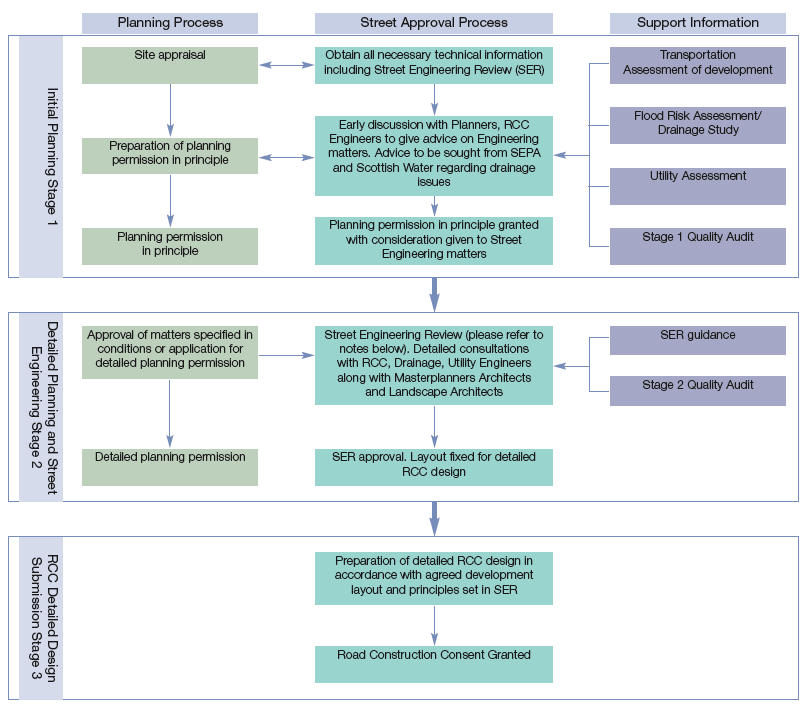Designing Streets: A Policy Statement for Scotland
Designing Streets is the first policy statement in Scotland for street design and marks a change in the emphasis of guidance on street design towards place-making and away from a system focused upon the dominance of motor vehicles.
Part 03 Process: How to achieve better outcomes

Atkins
How to achieve better outcomes
Designing Streets recognises that good design requires to be supported by an informed process. The large number of stakeholders involved in street design demands that the overlaps between professionals, decision makers and the public are fully integrated and work in a collaborative way.
policies
- Street design should be based on balanced decision-making and must adopt a multidisciplinary collaborative approach
- Street design should run planning permission and Road Construction Consent ( RCC) processes in parallel
Joint working processes
Street design involves a wide range of contributors and it is essential that these individuals and organisations work together from the earliest point towards a common objective - the delivery of distinctive streets where functionality is accommodated within a positive sense of place.
It is important for the various parts of local authorities to work together when giving input to a development proposal. Developers may be faced with conflicting requirements if different parts of local authorities fail to coordinate their input. This can cause delay and a loss of design quality. This is particularly problematic when one section of a local authority - for example the roads adoption/Roads Construction Consent ( RCC) or maintenance engineers - become involved late in the process and require significant changes to the design. A collaborative process of partnership and cooperation is required from the outset between all relevant parties.
Similarly, it is vital that developer teams also work in an integrated manner to deliver quality street design and provide appropriate interfaces with local authorities and other stakeholders. Engagement with agencies is encouraged as early as possible, preferably at pre-application stage. Detailed policy issues must be addressed as early in the process as possible in order to integrate solutions and streamline processes.
Ongoing dialogue between all parties - developer teams, authorities, agencies, the public including disability groups and access panels - is essential.

John Thompson & Partners
Case study
PARC Craigmillar, Edinburgh
PARC Craigmillar is a joint venture company between the EDI Group Ltd and the City of Edinburgh Council. Together with groups and representatives from the Craigmillar community, the Company works on the regeneration of the Craigmillar area in Edinburgh.
Central to the regeneration project is the innovative approach to street design. The project contains successful Shared Space/Home Zone areas and level surfaces that link the residential streets and new primary schools campus, providing an area in which vehicle movement is secondary to the activity of pedestrians.
Much of the Shared Space area is constructed with permeable paving, which integrates drainage functions within the on-street parking bays and carriageway build-up. The design of the carriageway was undertaken in a collaborative process with the City of Edinburgh Council, to a standard that allowed the Council to adopt the streets including the areas of permeable paving. Careful and efficient incorporation of underground utilities and services was paramount to ensure the successful design of these streets.
PARC Craigmillar's Shared Space development at Wauchope Square has been nationally recognised - winning the best Home Zone category in the UK Street Design awards 2009, awarded by Local Government News.
The work at Craigmillar illustrates how many of the functions of streets can be integrated in both innovative designs and collaborative processes that result in streets with a distinctive and positive character and excellent functionality.

Keith Hunter

Keith Hunter
Joint planning permission & RCC processes
Research carried out for the Scottish Government in 2005 identified ways in which the Roads Construction Consent process could be better integrated with the planning approval process. This process has now been updated accordingly, and will provide greater certainty for developers taking forward more innovative designs and meet government objectives for streamlining the planning process. The chart below illustrates a method to follow to comply with the national policy on this matter.
Residential street approval process

Street Engineering Review ( SER) Notes
Undertake SER in accordance with Local Authority guidance and relevant national policy/guidance (e.g. Designing Streets).
SER to include areas such as:
- Agreement of street layout including landscaping proposals in relation to the following:
- Vehicle tracking of layout (particular attention to be given to refuse vehicles and buses)
- Approval of key visibility splays
- Speed control
- Agreement of drainage discharge rates
- Agreement of SUDS techniques
- Schematic drainage layout for foul and surface water including dimension requirements against building and landscaping
- Key materials palette
- Utilities strategy
In some instances, insufficient detail may exist at planning permission in principle stage to justify RCC processes to take place. Balanced decisions on individual applications are required.
Quality Audits
The Quality Audit process aims to allow for more innovative design solutions where over safety-cautious practices can be omitted in favour of creating places that are high quality and enjoyable to use.
A Quality Audit draws together assessments by various professionals, and each may be undertaken within particular guidelines. By grouping the assessments together, any compromises in the design will be apparent, making it easier for decision makers to view the scheme in the round.
Quality Audits can ensure that street designs are appropriate and meet the objectives agreed at the outset. Documented audit and sign-off systems also provide a strong defence against any liability claims that may arise after the scheme has been implemented.
Quality Audits are particularly beneficial in the following circumstances:
- at option testing stage;
- at pre-application stage;
- where strong tensions exist between different objectives, a Quality Audit will aid more balanced decision-making;
- for schemes within existing streets, where a quality audit will provide an opportunity for decision-makers to make a balanced assessment of different considerations before approving a particular solution; and
- for smaller schemes where no Design Statement will be required.
The audit may include documents required by the local planning authority to support an application.
A Quality Audit should be integral to the design and implementation and not a tick box exercise. A typical audit may include some of the following assessments but the content will depend on the type of scheme and the objectives which the scheme is seeking to meet:
- an audit of visual quality
- a review of how the street will be used by the community
- a Road Safety Audit
- an inclusive access audit
- a walking audit
- a cycle audit
Road Safety Audits ( RSA)
The purpose of the RSA is to identify potential road safety problems. Road Safety Audits can be a key component within an overall Quality Audit. Road Safety Audits are routinely carried out for many road schemes. The Institution of Highways and Transportation ( IHT) Guidelines on RSA sit alongside the relevant standard contained in DMRB as the recognised industry standard documents in the UK. The procedures set out in DMRB , however, are a formal requirement for trunk roads only.
It is important to understand that RSAs are not mandatory for local road authorities. Many residential streets, where the design is carried out by a developer's consultant, are assessed independently by the local roads authority. In many authorities, there is no requirement for a further check by a Roads Safety Audit team, particularly where it is clear that motorised traffic volumes and speeds, and the degree of potential conflict between different user-groups, is not going to be significant.
An RSA is not a check on compliance with design standards. Audits should take all road users into account, including pedestrians and cyclists. The auditor reviews the proposals and the local authority decides whether or not to accept particular recommendations.
It is also important to note that the design team retains responsibility for the scheme and is not governed by the findings of the report. There is, therefore, no sense in which the scheme passes or fails the RSA process. Designers do not have to comply with the recommendations of a Safety Audit although, in such cases, they would be expected to justify their reasoning within a written report.
The process set out in DMRB requires the audit team to be independent of the design team, and road safety issues are therefore often considered in isolation from visual quality and successful place-making issues. It can therefore be difficult to achieve a balanced design through dialogue and compromise. The requirement for independence need not, however, prevent contact between the design team and the audit team throughout the process.
The involvement of road safety professionals as an integral part of the design team is recommended to help to overcome problems. This allows ideas to be tested and considered in more balanced and creative ways, and should overcome situations where perceived safety issues lead to late changes to schemes, often to the detriment of design quality.
Another area of concern with the current system is that RSAs may seek to identify all possible risks without distinguishing between major and minor risks, or quantifying the probability of them taking place. There can also be a tendency for auditors to encourage designs that achieve safety through segregating vulnerable road users from road traffic. Such designs can perform poorly in terms of streetscape quality, pedestrian amenity and security and, in some circumstances, can actually reduce safety levels.
It would therefore be useful if RSAs included an assessment of the relative significance of any potential safety problems. A risk assessment to consider the severity of a safety problem and the likelihood of occurrence would make it considerably easier for decision-makers to strike an appropriate balance. An example of a risk assessment framework is given in Highway Risk and Liability Claims. 50
There is a problem
Thanks for your feedback